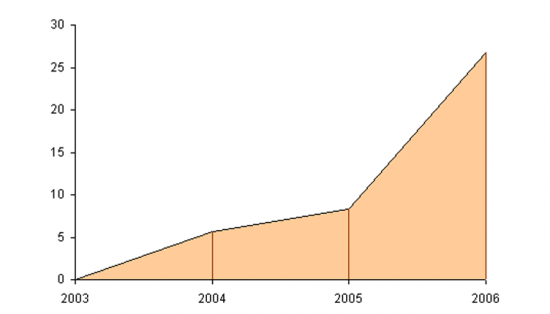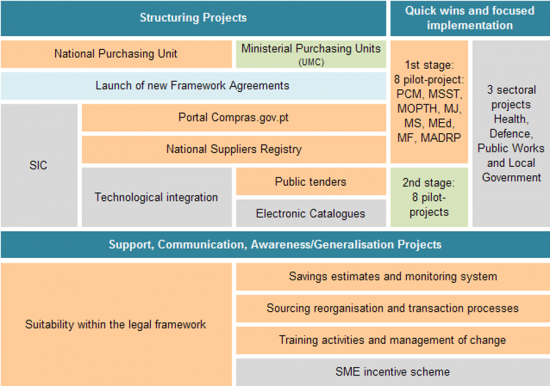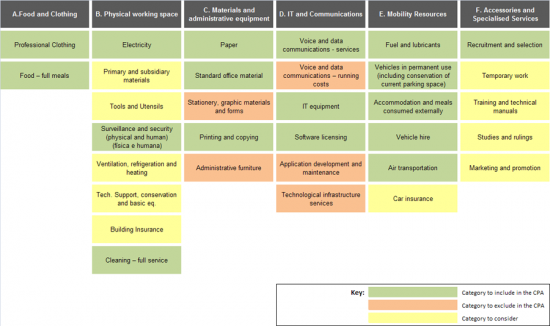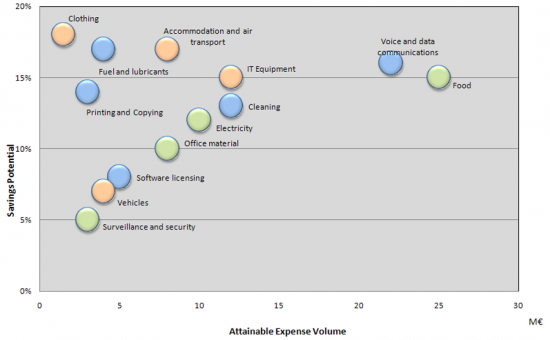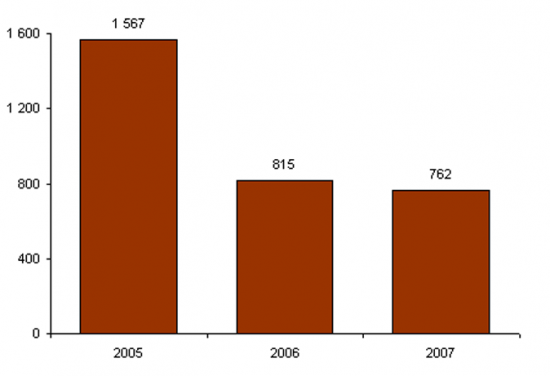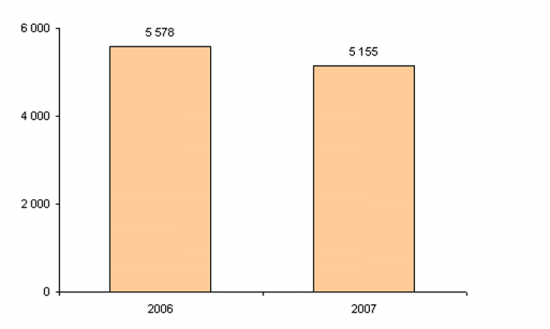

 Public Services
Public Services  Projects
Projects  National Programme for eProcurement
National Programme for eProcurement National Programme for eProcurement
The National Programme of Electronic Purchases (PNCE) was approved in June 2003 with the aim of introducing electronic tools as day-to-day instruments in public purchasing activities.
PNCE has stimulated the adoption of business practices and electronic commerce by enterprises, and a global vision of the purchasing process aimed at increasing its efficiency and transparency.
The Knowledge Society Agency (UMIC) was responsible for the setting up and coordination of the programme, which has led to major changes in public purchasing processes in Portugal.
The first stage of the programme, which ran until the end of 2005, directly involved 7 ministries and the Presidency of the Council of Ministers, 52 cases of aggregation and negotiation, 370 entities and 12 product categories.
2005 witnessed a significant extension of the programme, and from the beginning until the end of that year: the number of cases of aggregation and negotiation carried out since the start of the programme in 2003 went from 27 to 52, the number of entities involved went from 19 to 370 and the number of product categories covered went from 4 to 12.
In the second stage, which started at the beginning of 2006, the programme now covered all the 14 ministries and the Presidency of the Council of Ministers, the number of cases of aggregation and negotiation carried out since the beginning was generalised to all the entities of the ministries involved in the first stage. At the end of 2006 the programme now involved 918 entities and the number of aggregation and negotiation processes carried out since the start of the programme totalled 103. The evolution of the organisation structure which was built up for the various stages of the project is shown in the following diagram.
Evolution of the Organisational Structure of the National Programme for eProcurement
Alternative Access: 
press the image below to enlarge this
Source: UMIC - Knowledge Society Agency, P.I
At the start of the programme the establishment of purchasing nuclei at a ministerial level within a logic of shared services, which were served by electronic purchasing platforms through their own purchasing contracts, was shown to be particularly effective, since it resulted, in most cases, in the formation of highly motivated intraministerial groups possessing an innovative spirit. Besides this, it led to the development of essentially three service providers of electronic purchasing platforms which would reach performance levels which were unheard of prior to the programme. These service providers have been an important dynamising resource at the ministerial level and a means of modernising procedures. It was clear that, once this objective had been reached, the next step would involve a reduction in the number of purchasing contract electronic platforms, since one of these platforms could serve several Ministries. This step had to be taken rationally and involved regulatory aspects of a service provided by a very small number of suppliers.
From the outset of the programme UMIC had encouraged coordination meetings, and a regularity which was almost monthly, with representatives from the key ministerial purchasing units of the Ministries involved. These meetings played an important role in communicating the initiatives developed by the various nuclei, dynamising their activities and sharing good practices and information about purchasing processes being planned. This latter aspect frequently enabled the aggregation of several ministries within the purchasing process through the leadership of one of them, and also enabled ministries to be associated to a number of these processes which had not yet become directly integrated within the programme, given that the purchasing processes being planned were announced to all the Ministries with the aim of those interested being able to join these ongoing purchasing processes, and thus also enabling them to be able to benefit from the programme and contribute towards greater purchasing aggregation.
The total value negotiated from the start of the programme until the end of 2006 was 41 million Euros, with a saving of around 20%.
The rapid increase in the programme is clearly evident in the following graphic showing the value, in millions of Euros, negotiated by the PNCE each year. It can be seen that in 2005 there was a growth of 33% in the total value negotiated in relation to the sum of the previous two years, and in 2006 the value of eProcurement more than tripled in relation to the previous year and almost doubled in relation to the sum of the preceding three years since the programme had started.
Total value negotiated with the National Programme for eProcurement
2003 a 2006, (millions of Euros).
Alternative access: 
Click on the image below to enlarge this
Source: UMIC - Knowledge Society Agency, P.I, July 2006.
The main objectives laid down for the PNCE were to:
- Promote efficiency in the public acquisition process by:
- creating structural gains and savings;
- facilitating and enlarging access by enterprises to public procurement;
- increasing the transparency and quality of the service provided.
- Set up modernisation dynamics amongst economic agents by:
- promoting their competitiveness and productivity ;
- inducing the adoption of new eCommerce practices at a national level.
The PNCE was practically achieved through being organised into three types of project: Structuring, quick wins and support, as shown in the figure below.
Organisation of the National Programme for eProcurement into Projects
Alternative access: 
press the image below to enlarge this
Source: UMIC - Knowledge Society Agency, P.I.
In 2006 UMIC ordered a study to update the savings estimates which had been calculated in 2003 from Capgemini. Total annual expenditure of the Central Public Administration is estimated at around 8 billion Euros, of which 2.2 billion Euros involve transversal expenses, including 1.3 billion Euros in 16 categories which were the source of Public Procurement Contracts (CPA). In that study, it was estimated that the total saving in transversal expenses could reach 185 million Euros by 2010, and it recommended prioritising sourcing activities into three categories of products and services based on savings potential and ease of implementation, as shown in the figure below.
Prioritisation of Sourcing Activities
Budget categories in terms of Savings Potential (%), Ease of Implementation (Low and High) and Financial Volume (M€)
The volume of each category is proportional to the diameter of the circle (scale: Communications = 119 M€)
Alternative access: 
press the image below to enlarge this
Source: Capgemini, 2006, study commissioned by UMIC.
The same study segmented the transversal expenses of the Central Public Administration into 6 families of needs, from the point of view of demand, and organised them into 34 purchasing categories, which were divided into three groups – categories to include in Public Procurement Contracts (CPA), categories to exclude from CPA, and categories to consider in a second stage - as shown in the figure below.
Organisation of Purchasing Categories and Public Procurement Contracts (CAP)
Budget categories in terms of Savings Potential (%), Ease of Implementation (Low and High) and Financial Volume (M€)
The volume of each category is proportional to the diameter of the circle (scale: Communications = 119 M€)
Alternative access: 
press the image below to enlarge this
Source: Capgemini, 2006, study commissioned by UMIC.
In the Capgemini study it was estimated that manageable savings in the categories which may be covered by the CPA was somewhere between 61 and 174 million Euros to be obtained in three stages, as indicated in the figure below.
Stages of Public Procurement Contracts (CPA)
Purchasing Categories according to Attainable Expense Volume (M€) and Savings Potential (%)
Alternative access: 
press the image below to enlarge this
Source: Capgemini, 2006, study commissioned by UMIC.
The study showed the possibility of savings gradually increasing until 2010 as shown in the figure below. These estimates were strongly dependent on forecasts that the 16 CPA would be successful in 2007; some had unexpected changes resulting in delays in enabling the savings specified. It is essential to give maximum priority to the invitations to tender and the contracting of the CPA, and correct any aspects which are shown to be inadequate in the procedures adopted, so that it is possible to reach the estimated savings targets.
The holding of international tenders for the 16 CPA under consideration takes on maximum priority, so that is it possible to rapidly achieve the possible savings and overcome the problems noted in the tenders launched by the Directorate-General for Patrimony in 2006 which resulted in significant delays in public procurement progress.
Evolution over Time of Savings Obtained (2003-2006) and Estimated (2007-2008)
Millions of Euros, 2006
Alternative access: 
press the image below to enlarge this
2003-2006: Savings made in the pilot projects already carried out
2007-2010: Potential savings from new Public Procurement Contracts
Source: Capgemini, 2006, study commissioned by UMIC.
Of note is that the CPA in force – outdated and placed as a show strategy – do not enable the significant savings to be made and in the majority of cases enable an easier public procurement process. Indeed, the corresponding processes were essentially designed to facilitate purchasing processes by public bodies, without concerns to rationalise the purchasing process and the carrying out of savings to stimulate competition. The Ministerial Directives which ratified the CPA entered into by the Directorate General of Patrimony mostly extended beyond the period of validity of three years as foreseen, and remained in force until the date of the ratification of the new Public Procurement Contracts. This outdating has distorted the functioning of the market, since many of the main suppliers currently operating in the market could not be considered and, besides this, they have not taken advantage of competitiveness which, to be stimulated, requires a much greater dynamic, selectivity and much shorter CPA periods of validity – one could say almost the exact opposite philosophy to the normal operating principles.
Thus, the situation with regard to the CPA has in effect been working against the development of the PNCE. What is more, all the PNCE strategy, as well the similar programmes in other countries, is based on the suitable management of its CPA. Most of the savings made within the PNCE require the updating of the CPA, their widening to other categories and a new more regular, dynamic and selective tendering philosophy which stimulates competitiveness.
In conclusion the implementation of the new model of public procurement involves three main dimensions:
- Reformulation of the organisational model of public procurement, with the setting up of Ministerial Purchasing Units (UMCs) and the National Agency for Public Procurement (ANCP), with the latter located in the Ministry of Finances and Public Administration, and with the main aim of centralising the processing of sourcing for each of the Ministries within the Secretaries-General, which would allow the rationalisation of the number of purchasing structures, thus eliminating duplications and processes.
- Launching of new Public Procurement Contracts.
- Development of the Technological Model to support public eProcurement.
Implementing the Technological Model includes the following projects managed in a centralised manner (started by UMIC and transferring to the National Agency for Public Procurement):
- Public Procurement Portal – made publicly available by UMIC in April 2005, and with a subsequent gradual extension of services;
- Payments Platform – shared with the Citizen's Portal and the Enterprise's Portal;
- Tool for Aggregating the Purchasing Needs of the Public Administration – conceptual model approved and then being developed, with 10 pilots in August/September 2006;
- Download Tool for Contract Specifications – development concluded, with 15 pilots in August/September 2006;
- National Suppliers Registry (RNF) – development adjudicated and project started in September 2006;
- Catalogue Management and Catalogue Purchasing Systems – procurement procedure carried out in 2006 (proposals under analysis);
- Contract Management Tools (project to be launched in 2007);
- Purchasing Information Management System – (pilot) procedure launched in 2006.
In addition to the aforementioned tools, tools created in the different sectors by ministerial purchasing units (UMCs) or bodies should be included, and those already available on the market include:
- Invitation to Tender Electronic Platforms (tools used by the UMCs in the pilot phase, presently being adapted);
- Dynamic Negotiation Tools (tools used by the UMCs in the piloting phase, available from three suppliers);
- Transactional Purchasing Management Platforms (tools used by the ministerial purchasing during the piloting phase, available from three suppliers).
UMIC also ensured the development of a set of support projects, from which until now can be highlighted the following:
- Contribution to the legislative framework of the National Agency for Public Procurement;
- Contribution to the legislation reforming public procurement, specifically the transposition of community directives and preparing Public Procurement Legislation which has taken place in the Institute for Public, Private and Real Estate Markets (IMOPP);
- Development of the national sourcing strategy;
- Savings Estimates;
- PNCE monitoring system;
- Negotiation training sessions taught by a Professor from the Universidade Nova de Lisboa and an INSEAD trainer, attended by 90 Public Administration employees.
The Public Procurement Portal was made available in April 2005, and in its first stage it was mainly a source of information but it is planned to extend it in the future as an entry point to information systems providing support for public procurement. An English version of this portal will also be made available in September 2006.
The Public Procurement Portal was designed to contain information on:
- The National Programme for eProcurement and its implementation;
- Announcements of public procurement published in the Official Gazette the Diário da República;
- Existing catalogues and contacts responsible for procurement in the different Central Administration entities;
- National and international news on public procurement;
- Evolution of projects which are part of the PNCE;
- Suppliers of B2B services involved in PNCE projects;
- The most pertinent national and community legislation for public procurement;
- Good practices and data regarding public procurement and eCommerce.
This portal also started offering a range of services, including:
- News alerts of public procurement published in the Official Gazette the Diário da República to be sent to an electronic mailbox or by SMS text message, as specified.
- Pre-Registration of suppliers through their own initiative;
- Search engines;
- Newsletter;
- FAQ – Frequently Asked Questions.
During 2007 when it was transferred to the ANCP, the Public Procurement Portal had 1,500 newsletter subscribers, 1,340 subscribers to alerts through electronic mail, 1,360 valid supplier pre-registrations and 405 pre-registrations to be analysed, 10,730 announcements of invitations to tender, and had sent 27,500 SMS alerts.
"Number of supplier per-registration requests per year, under the scope of the PNCE - National Programme for eProcurement (Since the beginning of the PNCE in 2003)"
2005 to 2007, Number of pre-registrations.
Alternative access: 
click on the graph below to enlarge this
Source: UMIC - Knowledge Society Agency, P.I., July 2006.
"Number of invitations to tender announced in the Procurement Portal per year (Since the beginning of the PNCE in 2003)"
2006 and 2007, Number of invitations to tender.
Alternative access: 
click on the graph below to enlarge this
Source: UMIC - Knowledge Society Agency, P.I., July 2006.
"SMS Alerts sent per year, sent under the news alert scheme for procurement activity by the PNCE - National Programme for eProcurement (Since the beginning of the PNCE in 2003)"
2005 to 2007, Number of alerts.
Alternative access: 
click on the graph below to enlarge this
Source: UMIC - Knowledge Society Agency, P.I., July 2006.
Another activity aspect which had consequences regarding public procurement was the Reduction in Communication Costs. Under Decree-Law No. 1/2005 (text in Portuguese), of 4 January, UMIC was given permission to admit exceptions to the rule that services contracts involving communications should not go beyond three years, including extensions and renovations, as well as the rule that contracts which had started prior to the entering into force of the aforementioned Decree-Law could not be renewed. In addition to this, UMIC had been asked to cooperate with other public entities to prepare and monitor processes involving communications procurement. Of note in this regard is the contracting of the Land Mobile Service for Voice and GPRS Data for the Secretary-General of the Ministry of the Environment, Town and Country Planning and Regional Development which started with an invitation to tender in September 2006 and was concluded on 14 June 2007 with the signing of the respective contract with OPTIMUS – Telecomunicações, SA.
This tender was drawn up with the support of the Knowledge Society Agency (UMIC), under the scope of rationalising communication costs, in a process which started in May 2006 with work to identify the objectives and plan the tenders.
The following results are of note:
- Tariff cut by 61%, keeping the same range and amount of terminals and the same user profiles.
- Savings potential of more than 1 million Euros, based on user profiles studied and multiannual contract duration.
- Operator required to send indicators of service use on a regular basis.
- Use of requisitioning for the services under contract by the bodies covered via the eProcurement platform used by the Ministry under the National Programme for eProcurement .
- Implementation of the procurement project within a year (conceived at end of May 2006 and finalised upon signature of the contract in mid-June 2007).
- Survey carried out in approximately one month, with 97% positive replies.
The strategy chosen for communication negotiation was to take a phased approach with the different technologies (Land Mobile Service for Voice and GPRS Data, Landline Service and Data Network Service), with the following objectives:
- Successfully conclude the entire centralised negotiating process in less than one year (deadline set at the outset), from surveying the conditions for the call for tenders up to contract closure with an Operator.
- Focus on cutting costs, guaranteeing a return in the first year on any costs incurred.
- Keep interacting where necessary with the bodies involved so as to minimise the impact of a centralised contract on each body’s specific needs.
The first centralised communications negotiation success story monitored by UMIC took place in the Ministry for the Economy and Innovation (MEI). Negotiations were held for Land Mobile, Landline and Data Network Services. These first three procedures proved the viability and the value of centralised negotiation, and allowed the MEI to obtain a large reduction (of the order of 50%) in its communications tariffs.
In the case of the Secretary-General of the Ministry of the Environment, Town and Country Planning and Regional Development its starting point was the experience obtained in the MEI case, and so redesigned the methods of surveying and carrying out and the project, reinforced the legal structure of the procedural elements and invested strongly in the rigour and credibility of the target scenario presented for evaluation. These operational factors enabled all those tendering to take part in the negotiations pro-actively and led to results that are of manifest benefit to all bodies associated with the project.
Responsibility for the continuing and adopting of electronic procurement methods, which had been assured by UMIC under the scope of the National Programme for eProcurement (PNCE) passed to the National Agency for Public Procurement (ANCP), from 9 May 2007, following the start of activities by this new body, to which was transferred the competencies which UMIC had in PNCE, following the publication of the organic law and the statutes of the ANCP in the Official Gazette Diário da República on 19 February 2007, and the members of the Administration Council taking up their posts on 9 May 2007 (see  Intervention of the Minister of State and of Finances (text in Portuguese) (79.38 KB)), with continuity ensured by the transfer of the member of the UMIC Management Board responsible for electronic public administration projects to become a member of the ANCP Board of Directors.
Intervention of the Minister of State and of Finances (text in Portuguese) (79.38 KB)), with continuity ensured by the transfer of the member of the UMIC Management Board responsible for electronic public administration projects to become a member of the ANCP Board of Directors.
Information about eProcurement now became available on the Internet at the National Agency for Public Procurement (ANCP) (site in Portuguese) website and at the Public Contracts Portal (site in Portuguese).


